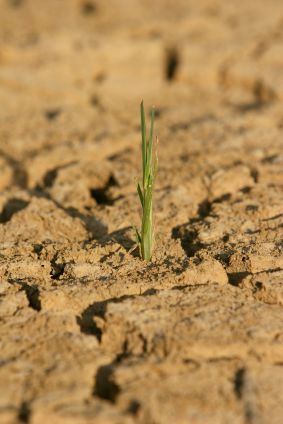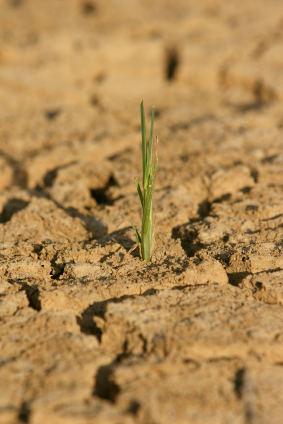 High and dryIn the United States, when people say “eat your veggies,” they are essentially urging you to take a bite out of California — or, more to the point, take a a big swig of its increasingly scarce water supply.
High and dryIn the United States, when people say “eat your veggies,” they are essentially urging you to take a bite out of California — or, more to the point, take a a big swig of its increasingly scarce water supply.
How much do we rely on California for fruits and veg? With its rich soils, variety of microclimates, long growing season, and huge geographical footprint, California should be a major ag producer — certainly a regional food-production hub for the southwest. But its sheer dominance of U.S. fruit and veg production (numbers from the the California Department of Food and Agriculture (PDF)) is dizzying.
The state produces 99 percent of the artichokes consumed in the U.S., half of asparagus , a fifth of cabbage, two-thirds of carrots, 86 percent of cauliflower, 93 percent of broccoli, and 95 percent of celery. Leafy greens? California’s got the market corned: 90 percent of the leaf lettuce we consume, along with and 83 percent of Romaine lettuce and 83 percent of fresh spinach, come from the big state on the left side of the map. Cali also cranks out a third of total fresh tomatoes consumed in the U.S. – and 95 percent of ones destined for cans and other processing purposes.
As for fruit, I get that 86 percent of lemons and a quarter of oranges come from there; its sunny climate makes it perfect for citrus, and these fruits store relatively well. Ninety percent of avaocados? Fine. But 84 percent of peaches? Eighty-six percent of fresh strawberries?
We in the other 49 states can do better. And will probably have to, soon. California’s most ag-centric counties, mostly clustered in the fertile Central Valley, are also its most heavily irrigated. And the Central Valley is locked in a three-year drought that shows no sign of easing up. From NPR:
California is in its third year of drought, and many farmers in the state’s crop-rich Central Valley are looking at dusty fields, or worse, are cutting down their orchards before the trees die.
Hardest hit is Westlands, the biggest irrigated region in the country, where much of the nation’s fruit, nuts and produce come from. This year, farmers have been told they are getting only a small fraction of the water they need.
On top of the drought, farmers are also feeling a water pinch from another source. The area’s farms have for years relied on a generous flow of water from a vast estuary called the Delta, where two big rivers meet in the center of the valley. But by sucking water out of the Delta before it reaches the ocean, Central Valley farmers are placing massive pressure on the coastal ecosystem Remember, they’re doing it to grow us our veggies–meaning that we veggie eaters are implicated in the damage being wrought.
Evidently, the lack of fresh water — along with pollution and the introduction of invasive species — has triggered population collapse for the delta smelt, the fish at the bottom of the ecoystem’s food chain. Take away the smelt, and other, higher-on-the-food-chain species decline, too. Here is the Center for Biological Diversity:
This smelt’s catastrophic decline is a warning that we may lose other native Delta fish that have fallen to alarmingly low levels as well, such as longfin smelt, salmon, and sturgeon. In fact, the delta smelt is only one of 12 of the original 29 indigenous Delta fish species that have been eliminated entirely from the area or that are threatened with extinction.
To stem the collapse of the smelt, a federal judge has ruled that much more water must flow into the Delta–just as the Valley’s farmers face a drought.
Meanwhile, water diversion isn’t the only way industrial agriculture affects this once-highly productive ecosytem. Get this:
The Delta habitat for delta smelt is polluted with often-lethal concentrations of herbicides and pesticides discharged and transported from California’s Central Valley into the fish’s estuary home. Toxic pulses of pesticides have been documented in the Delta during critical stages in fish development, and pesticides have been implicated in the recent collapse of the delta smelt population.
So let’s review. Our nation’s fruit-and-vegetable basket is extremely vulnerable to drought–and as a matter of course is wiping out a once-vibrant coastal ecosystem. Moreover, after produce is harvested there, it gets hauled in gas-guzzling refrigerated trucks to points across the continent–often right past farmland perfectly suited to fruit and veg production.
At one point, it must have seemed hyper-efficient to concentrate the great bulk of U.S. veggie production in a few fertile California counties. Now it looks reckless.
Here’s a not-even-half-baked plan for remedying the situation. Let’s slap a small but nontrivial tax on produce from water-poor California counties. Let’s apply it at the wholesale level — letting big players like Wal-Mart, Sysco Foods, and McDonald’s deal with it. Half of the proceeds go to grants to farmers in those counties, to help them transition to less water-intensive systems. The other half goes to a fund to help rebuild local and regional food and veg production across the nation. Say, by funding farm-to-school programs? Discuss.


